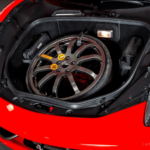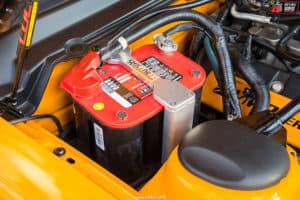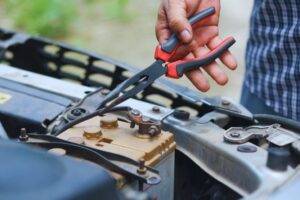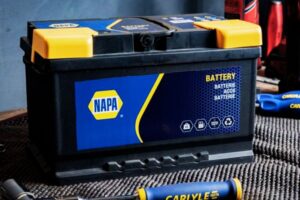Push starting a car is a common technique used when the battery is dead or the starter motor is not working. However, there is a common misconception that this technique can be used with any type of car, including automatics. So, can you push start an automatic car?
The answer is no. Unlike manual transmission cars, automatics do not have a clutch pedal that can be used to engage the engine. Push starting an automatic car can damage the transmission and other components, and it is not recommended by car manufacturers.
If your automatic car won’t start, the best option is to call a tow truck or use a portable jump starter to recharge the battery.
It is important to note that some newer cars with push-button start systems may have a backup method for starting the car if the battery is dead. However, this method still requires the use of the car’s electronic system and cannot be done by simply pushing the car.
It is always best to consult the car’s manual or contact the manufacturer for specific instructions on how to start the car in case of a dead battery.
Understanding Automatic and Manual Transmissions

Automatic and manual transmissions are two different types of systems that allow a vehicle to shift gears.
As per Progressive (.com), the main difference between them is that a manual transmission requires the driver to manually shift gears by using a clutch pedal and a gear shift, while an automatic transmission shifts gears automatically.
When a driver presses the clutch pedal in a manual transmission, it disengages the engine from the transmission, allowing the driver to shift gears. The engine’s torque is then transferred to the crankshaft, which is connected to the flywheel.
The flywheel is then connected to the input shaft of the transmission, which is responsible for transmitting the engine’s torque to the wheels.
In an automatic transmission, the driver does not need to use a clutch pedal or gear shift. Instead, the transmission uses a torque converter to transfer the engine’s torque to the transmission.
The torque converter is a fluid coupling that uses a special fluid to transfer torque from the engine to the transmission. The fluid is pumped by the transmission’s pump, which is driven by the engine.
The torque converter is responsible for transmitting torque to the transmission’s input shaft, which is then responsible for transmitting torque to the wheels.
There are different types of automatic transmissions, including the traditional torque converter, which uses a special fluid to transfer torque from the engine to the transmission. The proper fill of the transmission fluid is important for the transmission to function properly.
It is recommended to have a transmission fluid service every 30,000 to 60,000 miles to ensure that the transmission fluid is clean and at the proper level.
In an automatic transmission, there is no clutch pedal, and the transmission uses special fluid clutches to engage and disengage the gears.
The clutch is responsible for transmitting torque from the engine to the transmission’s output shaft. In an automatic transmission, the clutch is always engaged, which means that the output shaft is always turning.
This is why it is not possible to push start an automatic car, as the open clutch in the automatic transmission prevents the car from gaining momentum and speed, which is required to engage the clutch.
The Concept of Push Starting
As per Your Mechanic (.com), push starting, also known as bump starting, is a method used to start a vehicle with a manual transmission when the battery is dead or the starter motor is not working.
It involves getting the vehicle moving by pushing it or rolling it downhill, then engaging the clutch, and finally releasing the clutch to start the engine. This method works because the momentum of the vehicle provides the necessary energy to turn the engine over and start it.
However, the concept of push starting with an automatic transmission is different. Automatic transmissions are designed to start only when the ignition key is turned or the start button is pressed.
They rely on various sensors and computer-controlled systems to operate, which means that push starting an automatic car is not as straightforward as with a manual transmission.
According to some sources, it is not possible to push start an automatic car. The design of automatic transmissions does not allow starting the engine in any other way than the traditional one.
However, there are some exceptions to this rule. Some dual-clutch and continuously variable transmissions (CVT) may allow push starting, but it is not recommended by the manufacturers.
In theory, push starting an automatic car involves getting the vehicle moving by pushing or rolling it, then shifting the transmission into drive or low gear, and finally releasing the brake pedal to start the engine.
However, this method can be dangerous and can cause damage to the transmission and other components of the vehicle.
In conclusion, push starting an automatic car is not recommended and should only be done in emergency situations. It is always best to follow the manufacturer’s recommendations and use the traditional starting method.
Why Push Starting May Not Work With Automatic Cars

Push starting a car with a dead battery or a faulty starter motor is a common practice among drivers of manual transmission cars. However, if you have an automatic car, you may be wondering if you can push start it in the same way. Unfortunately, the answer is no.
The reason why push starting may not work with automatic cars is that automatic transmissions work differently from manual transmissions.
In an automatic car, the torque converter is the component responsible for transmitting power from the engine to the wheels. The torque converter is a fluid coupling that uses hydraulic pressure to transfer power from the engine to the transmission.
When the engine is running, the torque converter is spinning, and it generates hydraulic pressure that engages the transmission. However, when the engine is not running, there is no hydraulic pressure, and the transmission is disengaged.
This means that even if you push the car to get it moving, the transmission will not engage, and the engine will not start.
Another reason why push starting may not work with automatic cars is that some automatic transmissions, such as the Hydramatic, have a park pawl that prevents the transmission from rotating when the car is in park.
This means that even if you put the car in neutral and push it, the transmission will not rotate, and the engine will not start.
In summary, push starting an automatic car is not possible because the torque converter needs hydraulic pressure to engage the transmission, and the transmission may have a park pawl that prevents it from rotating.
If your automatic car won’t start, you may need to jump-start the battery or call for roadside assistance.
Alternatives to Push Starting an Automatic Car
If you cannot push start an automatic car, what other options do you have? Here are some alternatives to consider:
Jump Starting
Jump starting is a common method of starting a car with a dead battery. This involves using another vehicle’s battery to give your car the power it needs to start. To jump start your car, you will need a set of jumper cables and another vehicle with a fully charged battery.
Connect the cables to the positive and negative terminals of both batteries, starting with the positive terminal of the charged battery and then the positive terminal of the dead battery.
Then, connect the negative terminal of the charged battery to a metal part of your car’s engine block, and the negative terminal of the dead battery to another metal part of your car’s engine block. Start the engine of the charged vehicle and let it run for a few minutes, then try to start your car.
Portable Jump Starters
If you don’t have access to another vehicle or don’t want to rely on finding someone to help you jump start your car, a portable jump starter may be a good option. These devices are compact and can be recharged by plugging them into a wall outlet.
They work by providing a burst of power to your car’s battery, allowing it to start. Portable jump starters are a good option for automatic cars, as they don’t require another car or person to work.
Remote Start
If your car has a remote start feature, you may be able to use it to start your car even if the battery is dead.
This feature allows you to start your car from a distance using a remote control. However, this will only work if your car’s battery is not completely dead and the remote start feature is still functioning.
Battery Replacement
If your car’s battery is old or not holding a charge, it may be time to replace it. You can purchase a new battery from a battery shop or auto parts store and replace it yourself or have a professional do it for you. A bad battery can cause a variety of problems, including difficulty starting your car.
Alternator Replacement
If your car’s battery is not charging properly, it may be due to a faulty alternator. The alternator is responsible for charging the battery while the car is running.
If it is not functioning properly, the battery may not be getting the charge it needs to start the car. If you suspect that the alternator is the problem, you should have it replaced by a professional.
In summary, there are several alternatives to push starting an automatic car, including jump starting, portable jump starters, remote start, battery replacement, and alternator replacement.
It is important to choose the method that is appropriate for your situation and to follow the proper safety precautions when working with car batteries.
Understanding the Role of Car Brands

Different car brands have different transmission systems and technologies. This means that some brands may allow you to push start an automatic car, while others may not.
For example, Ford cars equipped with the Fordomatic transmission system can be push-started, but only if the battery is dead. Similarly, cars with the Cruise-O-Matic transmission system can also be push-started, but only in certain situations.
On the other hand, some car brands like Toyota and Honda do not recommend push-starting their automatic cars. This is because their transmission systems are designed to work with the starter motor and battery, and push-starting may cause damage to the transmission system.
Mercedes-Benz, Mitsubishi, and Mazda are some other car brands that do not recommend push-starting their automatic cars. This is because their transmission systems are electronically controlled, and push-starting may cause damage to the electronic components.
It is important to note that push-starting an automatic car is not a recommended or safe practice. It should only be done in emergency situations, and even then, it is recommended to seek professional help instead of attempting to push-start the car.
Overall, the role of car brands in push-starting an automatic car depends on their transmission systems and technologies. It is important to check the manufacturer’s recommendations before attempting to push-start an automatic car.
The Importance of Professional Assistance
Push starting an automatic car can be a tricky and dangerous task, and it is not recommended for inexperienced drivers. If you are not familiar with the process, it is best to seek professional assistance from a mechanic or a towing service.
Attempting to push start an automatic car without the proper knowledge and tools can result in damage to the vehicle’s transmission or engine. Moreover, it can be dangerous if the car is not in a safe location or if the driver is not wearing proper safety gear.
In case of a breakdown, it is recommended to call for roadside assistance or a tow truck to transport the vehicle to a repair shop. This is especially important if the car’s battery is dead, as jump-starting an automatic car can be more complicated than jump-starting a manual car.
Professional assistance can also be beneficial if the car needs repairs or maintenance. A mechanic can diagnose and fix any issues with the car’s transmission or engine, ensuring that it is in good working condition.
While it may be tempting to try to save money by attempting to push start an automatic car or perform repairs yourself, it is important to consider the potential risks and costs of doing so. Seeking professional assistance can save you time, money, and stress in the long run.
Safety Measures When Dealing With Car Batteries

Dealing with car batteries can be dangerous if proper safety measures are not taken. Here are some important safety tips to keep in mind when working with car batteries:
- Always wear protective gear such as gloves and safety glasses when handling car batteries. Batteries contain corrosive chemicals that can cause burns and other injuries if they come in contact with skin or eyes.
- Make sure the car is in park or neutral and the parking brake is engaged before attempting to start the car. This will prevent the car from moving while you are working on it.
- Do not smoke or use any open flames near the car battery. Batteries contain hydrogen gas that can ignite and cause an explosion.
- Use a battery charger or jumper cables to charge the battery. Do not attempt to jump start the car by pushing it or using a fan belt. This can damage the car’s starter and other components.
- If you must jump start the car, use alligator clips to connect the battery terminals. Make sure the positive and negative terminals are connected correctly. Failure to do so can cause a spark and ignite the hydrogen gas.
- When jump starting the car, start the car with the good battery first and let it run for a few minutes before attempting to start the car with the dead battery. This will help prevent damage to the car’s electrical system.
- If the car has a manual transmission, it may be possible to push start the car. However, this should only be done as a last resort and with extreme caution. Make sure the car is in second gear and coast downhill to gain momentum before engaging the clutch to start the engine.
By following these safety measures, you can ensure that you work with car batteries safely and avoid accidents or injuries.
Key Takeaways
Push starting an automatic car is not possible due to its open clutch system. The clutch in an automatic car is designed to disengage when the brake pedal is pressed, which makes it impossible to start the car by pushing it.
However, there are alternative methods to jump-start an automatic car. One of the most common ways is to use jumper cables to connect the dead battery to another car’s battery. This will allow the dead battery to charge and start the car.
It is important to note that jump-starting a car can be dangerous if not done correctly. Always follow the manufacturer’s instructions and take necessary safety precautions, such as wearing protective gloves and eye gear.
In addition, regular maintenance of the car’s battery and electrical system can help prevent the need for jump-starting in the first place. Keeping the battery clean and checking the alternator and starter regularly can help ensure that the car starts smoothly every time.
Overall, while push starting an automatic car is not possible, there are alternative methods to jump-start the car in case of a dead battery. Always follow the proper safety precautions and regularly maintain the car’s electrical system to prevent the need for jump-starting.



![How to Rev a Car Engine [Automatic and Manual] how to rev a car engine](https://roadsumo.com/wp-content/uploads/2022/03/how-to-rev-a-car-engine-150x150.jpg)





